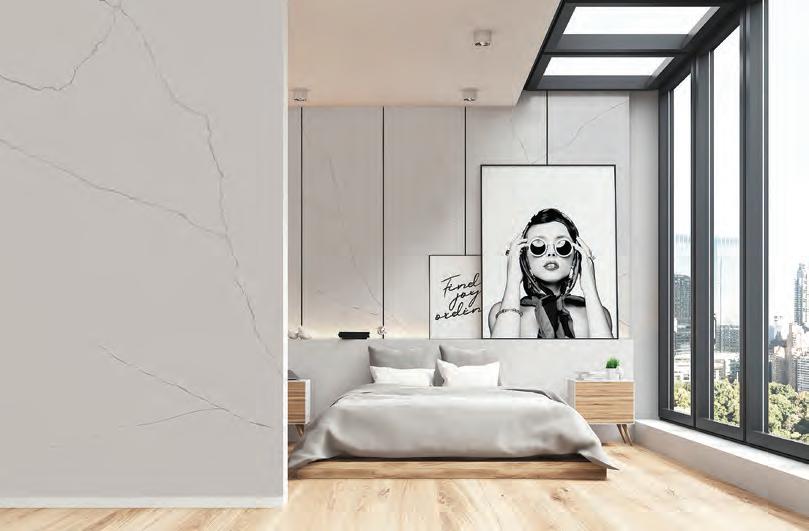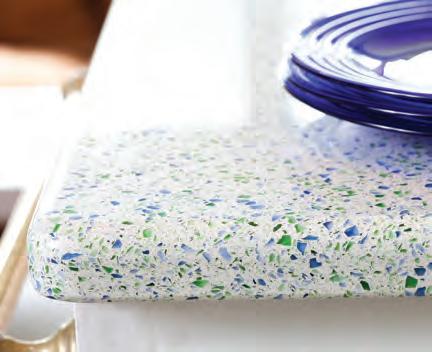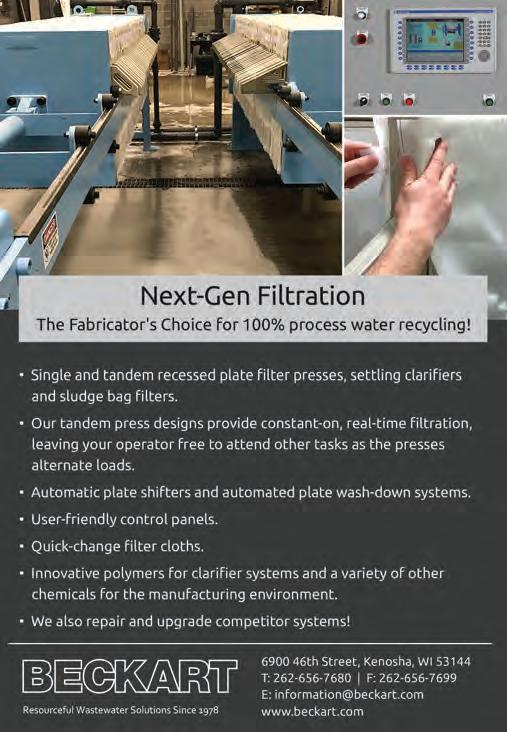
11 minute read
EMBRACING A CRYSTALLINE RENAISSANCE The changing face of quartz
Charles Darwin said, “In the long history of humankind (and animal kind, too) those who learned to collaborate and improvise most effectively have prevailed.” This statement essentially refers to the No. 1 skill of survival – adaptation. It seems that living and being reside on a fluid foundation. That is to say, just when you think you are rooted in place, the medium around you begins to move, shift and mutate. Inaction can be as deadly as wrong action, and therefore those businesses who are constantly taking the pulse of cultural norms, personal values and technologies are those best poised to adapt when the underlying current of being begins to shift and, it indeed has. We are beginning to see a 21st century renaissance and this bodes very well for not only the quartz industry but for all of the surfacing categories. The Renaissance was a period in history marking the transition from the Middle Ages to Modernity and was a time marked by genius and notable change. Cultural norms, values and even technology underwent sustainable reformation fueled by rejuvenation. Now take a look at 2020, a new decade launched with nearly unprecedented instability: pandemic, potentially life-changed elections, geo-political tensions, unemployment and racial tensions, just to name a few. The concurrence of these significant dynamics has, for many, led to an ever-present feeling that the global tide of Darwinism is shifting again. That said, we know that change is woven into the fabric of the human race, and the only thing we can be certain will not change is the fact that everything will eventually change. This Some engineered stone companies have been working to tackle issues related to sustainability. Their use of renewable bio-resins that are UV-stable, better allow for their use in outdoor applications, such as this kitchen fabricated
By Paul Max Le Pera and Jessica McNaughton
Since the early 2000s, the engineered stone (quartz surfacing) industry has experienced positive, profitable and prolific growth, globally. Relatively speaking, quartz surfacing embraces many attributes that continue to fuel its popularity and specification. That said, the category has also undergone some severe challenges in recent years, necessitating a sort of renaissance to ensure its sustainability.
from Diresco quartz. brings us back to the point that adaptation is the top survival skill, and that applies to not only animals, but also businesses.
We can be highly encouraged by several organizations within the surfacing industry that are adjusting their rudders as industry currents shift. Many firms are making a distinct effort to embrace sustainability, a movement that has been re-energized and is rapidly gaining increased global attention. The term essentially focuses on finding greener alternatives so as not to deplete natural resources and whose connotation is simple: finding ways to do things that last.
Engineered stone/quartz surfacing, with its continued growth in popularity among specifiers, such as architects, designers and even homeowners, is not immune from a host of changing conditions that require adaptation. Prime among these are the hefty tariffs that have been placed on Chinese quartz, ailing global economies and the emergence, or arguably the re-emergence, of engineered stone’s greatest hazard, silicosis. With these factors at the forefront of the product category’s challenges, it is most certainly experiencing a fluid foundation
The use of newer bio-resins that are free of cobalt allow for the easier development of complex veined patterns when used in quartz surfacing.
shift, necessitating sustainable adaptation. This adaptation will come from numerous avenues with the market ultimately being the judge of what will last.
First among the challenges quartz surfacing has been facing are the anti-dumping and countervailing duties placed on imports from China. These tariffs range as high as 500 percent, making the abundant supply available there far less attractive. However, this is not necessarily a bad thing. While for a short time in 2019 it may have had a slight effect on the availability from some suppliers, ultimately it helped drive the start-up of more lines in North America. This not only created jobs in more local economies to help defer the economic downturn in the industry, but it also lessened the carbon footprint caused by shipping material from such long distances. There are now more quartz surfacing production lines operating in North America than ever before.
Additionally, resins that are used in the formulation of engineered stone are most often petroleum based, thereby helping to deplete finite natural resources. Also, some of the resins used may be difficult to recycle or dispose of in a sustainable fashion.
A larger issue that seems to be playing a role within engineered stone circles is silicosis, a lung disease caused by breathing in tiny bits of crystalline silica, often referred to as respirable crystalline silica. Tragically, there is currently no known cure. Acute, chronic or accelerated cases can lead to lung cancer, tuberculosis, chronic obstructive pulmonary disease (COPD) and other dangerous breathing disorders for which the best current hope is to manage the symptoms, but eradication or reversal is not an option.
Silicosis has been known about for decades and is not endemic to the fabrication of engineered stone, and yet because of the high percentage of quartz within the product, the hazard is significant and the risks are very real. Classified as a human carcinogen in 2000, crystalline silica dust has been found in various other products, such as natural stone, concrete, ceramic and brick.
Now a global issue and arguably gaining momentum, the current of change in managing silicosis is a very hot topic. Respirable

crystalline silica mitigation/elimination is a constant source of study, innovation and enforcement for machine and tool manufacturers and shop owners alike. However, consistent with the sustainability movement, there may be some engineered stone formulation alternatives to mitigate, or possibly eliminate the respirable silica hazard.

When it comes to sustainability and engineered stone there are opportunities to modify the formulation to be eco-friendlier. As mentioned above, there are two primary areas. One is in the resin used in its manufacture and the other is the crystalline silica content.
At the highest level, we are seeing innovations from the resin companies, such as INEOS Composites. They have unsaturated polyester resins that are made from renewable resources instead of finite resources, meaning they replace the petroleum-based resins with bio-based raw materials without affecting the physical or handling properties of the resin. Their Envirez resins were among the first on the market in the category. INEOS was also one of the first movers on Cobalt-Free Technology, which became increasingly important when the European Chemical Agency (ECHA) was looking to classify cobalt salts as carcinogens and reproductive toxicants. Most resin systems recommend cobalt salts in order to get a proper cure in a quartz slab. INEOS introduced a cobalt-free technology that gets the same degree of curing in the slab without issues. Also, since cobalt is dark in color, the removal of it allows for better color control, enabling better veining patterns and even translucency in slabs. The GEOS resin-based recycled glass surface shown here uses larger, terrazzo-like recycled glass aggregates instead of quartz helping lower the amount of crystalline silica versus other engineered stones.
As far as innovations in quartz products themselves, there are several brands on the market that have started to pivot and adopt more sustainable practices.
Diresco, a Belgian company founded by a father and son team in 2003, was an early pioneer and adopter of the Bio-UV resin technology. Direscorecognized that a better bio-based resin was needed, and the company created one using readily renewable plantbased sources instead of petroleum. The resin is highly UV stable, allowing for a broader range of applications forDiresco, which combines the resin with quartz to create a variety of design options from traditional quartz to more veined and terrazzo looking styles. Direscoreclaims and recycles all water used in its manufacturing

process, generates its own electricity through wind and solar technologies, and because of the nature of the Bio-UV resin, all manufacturing byproduct waste is repurposed for soil control and road construction throughout Belgium rather than being sent to landfills. In addition, Direscocan be recycled back into production and used as new particulate in its Terrazzo line. Sustonable, an engineered stone manufactured in Turkey, opts for a recycled polyethylene terephthalate (PET) binder, making the material 15 to 25 percent recycled content. It is also 100 percent recyclable. The material is thermoformable as well, making it somewhat of a hybrid between standard quartz and solid surface. The company claims it is 50 percent stronger than composite stone, and is offered in 6mm, 8mm and 1cm thicknesses. Unlike other products, Sustonable is formed from a continuous extrusion process, which is said to reduce waste versus batch processes, and any waste that is generated can be recycled back into the process. The product is designed to be less brittle than some of its contemporaries, The recently released Obsidiana product from Compac (pictured here in Volcano Pearl) has tackled the issue of silicosis head-on by largely exchanging the use of crystalline silica with amorphous silica, whose dust does not cause adverse health problems. The product contains less than 7 percent crystalline silica, drastically decreasing the chance of silicosis from the fabrication process. It is made using 100 percent recycled glass and minerals as well as UV-stable bio-resin, and is also 100 percent
recyclable. which makes cutting and transporting it easier and allows the use of thinner materials without the drawback of breakage caused by impacts.
The recently released Obsidiana product from Compac, which is manufactured in Spain, also uses the Bio-UV resin mentioned previously. Obsidiana has tackled the issue of silicosis by using amorphous silica instead of crystalline silica. Amorphous silica, unless contaminated with crystalline silica, does not pose the health risks associated with crystalline silica. Obsidiana claims to be both recycled and recyclable and
uses up to 100 percent recycled glass and minerals in its composition with a sustainable manufacturing process as well. The product contains less than 7 percent crystalline silica, decreasing the chance of silicosis from the fabrication process. The company claims that the product cuts 30 percent faster than standard quartz, and there is no inherent tension in the material like there is with many ceramics. Thicknesses range from 7mm to 30mm. Obsidiana was recognized with the Sustainability Award at KBIS 2020.
While the focus of this article has been the changes that have been taking place in the quartz surfacing, similarities can be found within the recycled glass category of hard surfaces, which are akin to engineered stone.
Curava is an engineered stone that contains approximately 30 percent quartz. This is significantly less than many quartz surfaces, which typically contain in the range of 90 percent quartz, meaning it contains a lesser amount of crystalline silica. The remainder of its make-up is about 60 percent post-consumer and postindustrial recycled glass and roughly 10 percent resin binder. GEOS, which is another resin-based recycled glass surface is a product that uses a polymerbased resin with larger, terrazzo-like recycled glass aggregates instead of quartz. This helps lower the amount of crystalline silica versus other engineered stones. GEOS has recently revamped its color line, is 55 to 75 percent recycled glass by weight, and is available in both 2cm and 3cm thicknesses.
IceStone, which is made in Brooklyn, N.Y., from 100 percent recycled glass and cement instead of quartz, recently improved upon its petroleumfree recipe. New IceStone incorporates process steps that improve the performance of the product, retaining its sustainability story, but also increasing its stain resistance and durability. This improved version also is UV stable, making it suitable for outdoor applications.
There has definitely been some visionary restrategizing in the engineered stone arena, and it will be interesting to see how the market will embrace these innovations. The omnipresent increasing pressure for business and industry to embrace renewable energy and sustainable practices will only add to the options and best practices here. Quartz and all other engineered Surfaces are projected to increase in market share as their formulations can be adjusted to meet the growing practical and social needs. The renaissance we are witnessing in the surfacing industry is being heavily influenced by the growing sustainability movement, and whether it is a new surfacing category, a variant of an existing product, or a “new and improved” formulation, change can be a springboard for growth. Those who are able to pivot and adapt will be those more firmly rooted when the tide once again ebbs.
About the Authors
Jessica McNaughton, a former ISFA board member, is president of CaraGreen, a curator and distributor of best-in-class sustainable materials based in Raleigh, N.C. CaraGreen offers healthy alternatives to traditional building materials and serves as an educator on industry issues that have a human or environmental health impact, with several education courses on the latest green building standards and trends in the industry. She can be reached via email at jessica@caragreen.com or on the web at www.caragreen.com.
Paul Max Le Pera is president of Global Surfacing Alliance LLC, a global marketing, business consulting and product sourcing firm specializing in proprietary products and disruptive technologies. He is also on the ISFA Board of Directors and can be reached at PMax@ GlobalSurfacingAlliance.com.



